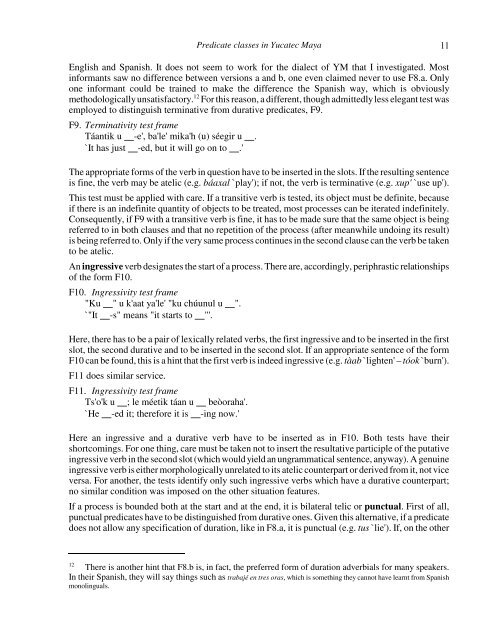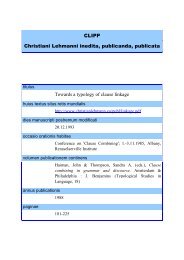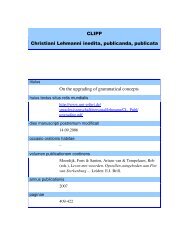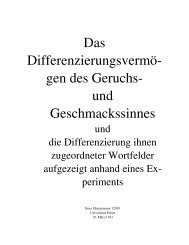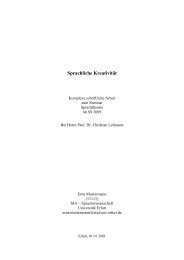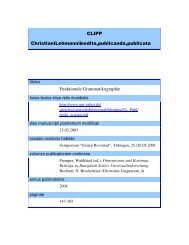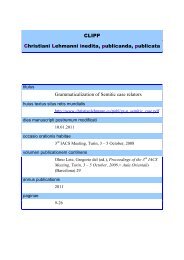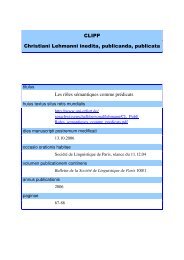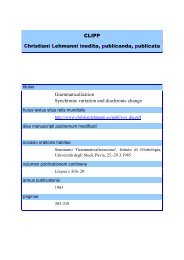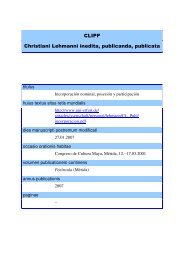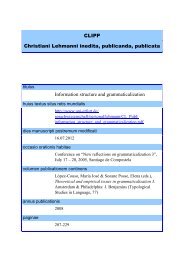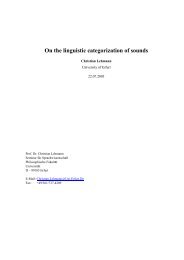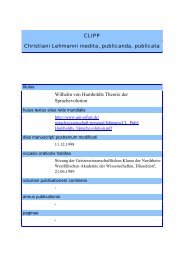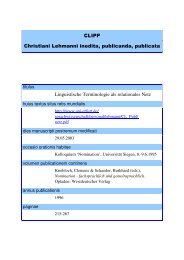CLIPP Christiani Lehmanni inedita, publicanda, publicata Predicate ...
CLIPP Christiani Lehmanni inedita, publicanda, publicata Predicate ...
CLIPP Christiani Lehmanni inedita, publicanda, publicata Predicate ...
You also want an ePaper? Increase the reach of your titles
YUMPU automatically turns print PDFs into web optimized ePapers that Google loves.
<strong>Predicate</strong> classes in Yucatec Maya 11<br />
English and Spanish. It does not seem to work for the dialect of YM that I investigated. Most<br />
informants saw no difference between versions a and b, one even claimed never to use F8.a. Only<br />
one informant could be trained to make the difference the Spanish way, which is obviously<br />
methodologically unsatisfactory. 12 For this reason, a different, though admittedly less elegant test was<br />
employed to distinguish terminative from durative predicates, F9.<br />
F9. Terminativity test frame<br />
Táantik u -e', ba'le' mika'h (u) séegir u .<br />
`It has just -ed, but it will go on to .'<br />
The appropriate forms of the verb in question have to be inserted in the slots. If the resulting sentence<br />
is fine, the verb may be atelic (e.g. báaxal `play'); if not, the verb is terminative (e.g. xup' `use up').<br />
This test must be applied with care. If a transitive verb is tested, its object must be definite, because<br />
if there is an indefinite quantity of objects to be treated, most processes can be iterated indefinitely.<br />
Consequently, if F9 with a transitive verb is fine, it has to be made sure that the same object is being<br />
referred to in both clauses and that no repetition of the process (after meanwhile undoing its result)<br />
is being referred to. Only if the very same process continues in the second clause can the verb be taken<br />
to be atelic.<br />
An ingressive verb designates the start of a process. There are, accordingly, periphrastic relationships<br />
of the form F10.<br />
F10. Ingressivity test frame<br />
"Ku " u k'aat ya'le' "ku chúunul u ".<br />
`"It -s" means "it starts to "'.<br />
Here, there has to be a pair of lexically related verbs, the first ingressive and to be inserted in the first<br />
slot, the second durative and to be inserted in the second slot. If an appropriate sentence of the form<br />
F10 can be found, this is a hint that the first verb is indeed ingressive (e.g. tàab `lighten' – tóok `burn').<br />
F11 does similar service.<br />
F11. Ingressivity test frame<br />
Ts'o'k u ; le méetik táan u beòoraha'.<br />
`He -ed it; therefore it is -ing now.'<br />
Here an ingressive and a durative verb have to be inserted as in F10. Both tests have their<br />
shortcomings. For one thing, care must be taken not to insert the resultative participle of the putative<br />
ingressive verb in the second slot (which would yield an ungrammatical sentence, anyway). A genuine<br />
ingressive verb is either morphologically unrelated to its atelic counterpart or derived from it, not vice<br />
versa. For another, the tests identify only such ingressive verbs which have a durative counterpart;<br />
no similar condition was imposed on the other situation features.<br />
If a process is bounded both at the start and at the end, it is bilateral telic or punctual. First of all,<br />
punctual predicates have to be distinguished from durative ones. Given this alternative, if a predicate<br />
does not allow any specification of duration, like in F8.a, it is punctual (e.g. tus `lie'). If, on the other<br />
12 There is another hint that F8.b is, in fact, the preferred form of duration adverbials for many speakers.<br />
In their Spanish, they will say things such as trabajé en tres oras, which is something they cannot have learnt from Spanish<br />
monolinguals.


